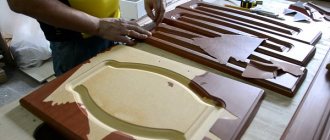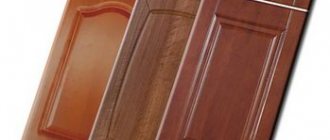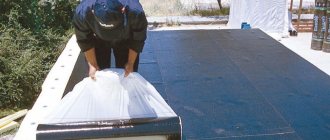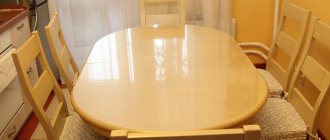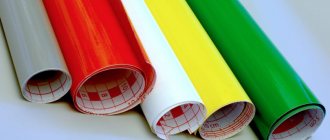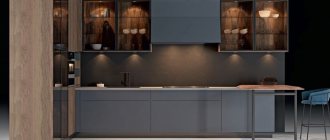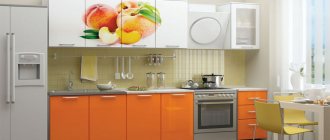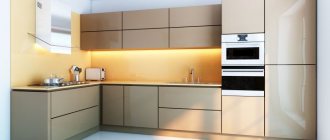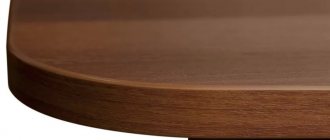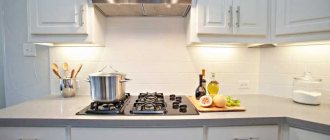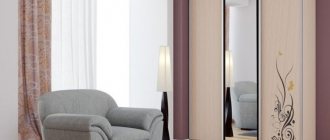The film on the facade of the MDF kitchen has peeled off: what to do, how to glue it
Hi all! Modern MDF kitchens are deservedly popular. This is the optimal balance between cost and quality. But it happens that the film on the facade of the MDF kitchen peels off, and it no longer looks the same as before.
This problem cannot be ignored under any circumstances, since the film plays not only a decorative, but also a protective function. With prolonged peeling, steam, fats, and temperatures will affect the MDF itself, which will have a detrimental effect on its condition and service life.
You can figure out how to put the peeled film back on yourself. Such repairs should not cause much difficulty. Please note that we will talk specifically about how gluing is performed, and not a complete replacement of the furniture façade film. Restoring film on facades with milling will be somewhat more difficult. This is due to the complex shapes of the product.
Features of operation
Think about it, PVC film sticks at a temperature of 120 - 180 degrees, and if your oven produces at least 60 -100 degrees outside, this already poses a threat to the cabinets located nearby.
Install the thermal insulation strip. It protects the ends of the cabinet from heating by the stove and avoids delamination of the edges. It is installed at the ends of the cabinet. It is very easy to care for: to remove dirt, it is recommended to wipe with a damp cloth, but it is not recommended to use any cleaning agents.
- Avoid high humidity. If you are still in doubt whether to install a hood or not, then I think your choice is now obvious. Steam from pots and grease from frying pans will also not have the best effect on your furniture.
- Water is the enemy of any furniture. Make sure that it does not get on the facades.
- Close doors and slide drawers carefully, avoiding sudden movements. Do not expose them to mechanical stress (contact with sharp objects, friction, impact).
- The close location of lighting fixtures can lead to excessive heating of the facade and, as a result, deformation of the film, as well as a change in the color of the facing coating. The lamp and the facade should not be closer to each other than 15 cm.
Why is this happening
Let's start by examining the reasons why the film on your MDF kitchen facade has peeled off.
This can happen for several main reasons. Next, you will learn what to do in this situation, how to glue it and how to protect the film from the oven and other provoking factors.
In reality there are quite a lot of reasons.
But even on high-quality surfaces, peeling is possible.
This mainly occurs due to the oven and on the facades adjacent to it.
What happens is this: The housewife is preparing some dish in the oven, which is heated to high temperatures. When you take out the dish, all the heat comes out and hits the façade. As a result, the glue melts, loses adhesion to the film, and it peels off.
There is a high probability of peeling off when exposed to sunlight. Gradual heating occurs, the film burns out, the glue dries out or melts. That's it, the grip is lost, and the result is obvious.
To summarize, the following main reasons can be identified:
Sometimes there are several causes at once, or only one factor influences.
The result is the same. The film has peeled off and needs to be fixed.
Construction and family forum
Apartment renovation, suspended ceilings, country construction of houses, cottages, baths, gardening, business forum, children, health.
- Unanswered topics
- Active topics
- Search
- HomeList of forumsConstructionRepair of apartments
- Search
How to glue PVC to MDF?
- Send topic by email
- print version
How to glue PVC to MDF?
- Complaint
- Quote
Post by Rita » Oct 28, 2022, 11:37 am
How to glue PVC to MDF?
- Complaint
- Quote
Post by Dmitry » 29 Oct 2022, 06:36
PVC (for example, lining) can be glued to MDF with glue from the “liquid nails” series, here is a very good option “Titan”, this is a special glue for panels including MDF panels and PVC.
Ways to solve the problem
The popularity and advantages of MDF facades are undeniable, but incidents also happen with them.
This is mainly due to the fact that operating rules or production technology have been violated. And sometimes two reasons at once.
Let me separately and as briefly as possible try to talk about restoration methods.
Friction recovery
This may seem strange to some, but the method really works.
It is best to use this technique in the early stages, when the film has only recently peeled off.
The meaning of the procedure is to perform the following sequential actions:
Just don't rub too quickly or vigorously. Take short breaks, don't put too much effort. Otherwise, the film may be damaged.
Heating with a hair dryer
An alternative would be another method of heating the film, but using an appropriate device.
A regular hair dryer may work, but it is better to use a construction hair dryer.
In this case, the sequence of operations is as follows:
The method will help if the glue has really dried out and lost its properties. Having melted it, it is often possible to restore it without using a new layer of glue.
Restoration with glue
Often home craftsmen first start with this method. But here everyone decides for himself.
To work, you will need quick-drying glue. Choose any one at your discretion.
The composition must be applied to the inner surface of the film and to the MDF facade itself. Then press and gently rub.
Difficulties in work and their solutions
Problems often arise with processing the ends and shaped parts of kitchen units made of MDF or other material. An industrial or household hair dryer will be a good helper in this case.
The restoration will go faster if you work together: one person stretches the material by heating it with a hairdryer, the other carefully glues it to the base.
It is easier to apply the self-adhesive tape evenly on a damp surface. To do this, lightly moisten cabinets and doors with a spray bottle. Water will not allow the material to immediately grasp the surface and will provide an opportunity to correct the work.
When cutting the material, you need to make allowances on each side. For parts with ends, do not forget to make cuts in the corners. First, they paste over the part itself, and then proceed to the ends. The rounded ends of MDF facades are treated with a hairdryer for a better fit.
Useful tips
Quite often, household members forget one simple truth.
MDF film does not like elevated temperatures, and therefore you need to try to insulate the material from strong heat. Otherwise, peeling will occur constantly.
Therefore, here I can highlight several practical recommendations:
Have you ever encountered films that peel off? How did you resolve this issue? What restoration methods were used?
Subscribe, leave comments, tell us about your situations and don’t forget to come to us again!
Source
Which film should I choose?
First of all, you need to look at the thickness of the material and the manufacturer. German “self-adhesive” tapes are of good quality; their price depends on the thickness.
Dutch and Italian manufacturers have proven themselves to be excellent. You can choose something from budget series or take a closer look at exclusive products, but then the price will be quite high.
The most inexpensive are Chinese adhesive decorative materials from unknown manufacturers. However, low price should not be the main selection criterion, otherwise a beautiful kitchen decorated with self-adhesive vinyl film can quickly lose its appearance.
Not all adhesive materials intended for promotional products can be used in the interior. Some of them are designed for short-term use. Choose high-quality decor, and then the restoration will be durable, and a simple kitchen cabinet will become an interior decoration.
The color can be any. If you want to take a creative approach to kitchen design, place photos of fruits, vegetables or flowers on the facades, thereby decorating ordinary old furniture. The drawing can also be applied using photo printing.
MDF in PVC film: how they glue it in factories and how to do it yourself - Review + Video
MDF in PVC film: how they glue it in factories and how to do it yourself. Often you want to give furniture a second life, or just change something in your apartment and do it inexpensively. Let’s not talk about what is better – film or painted MDF, but let’s immediately note that facades covered with film are the future. The fact is that such components are much more durable and neater looking, and, importantly, much cheaper to produce than painted or enameled MDF. Modern furniture with a bright glossy polymer coating is very beautiful.
When choosing a film for MDF kitchen facades, you should remember that even high-quality enamel will begin to peel off or swell after a while, so the service life of the film coating can last several decades without the need for repairs.
Types of self-adhesive PVC film
The film is responsible for the decorative appearance of doors and drawer front panels. She may be:
- matte, glossy, semi-matte;
- monochrome, with a geometric or abstract pattern;
- with imitation of the texture of stone or wood cut;
- with mother-of-pearl or metallic shimmer;
- with sparkles or flocks (colored splashes).
Such wide decorative possibilities are one of the main reasons for the popularity of MDF facades in PVC film.
Self-adhesive decorative film consists of three layers:
The front layer is the polymer film itself.
The second layer , which is responsible for adhesion to the surface of the part, is a synthetic rubber or acrylic adhesive for PVC film and MDF facades.
The third layer is siliconized paper, which protects the glue during transportation and storage of the kitchen film. The paper is removed immediately before pasting.
According to production technology, adhesive film for the kitchen comes in two types:
The first type is usually used on MDF kitchen facades with a “smooth” surface.
Molding is used for covering MDF boards with three-dimensional relief with film. It stretches well even without preheating, and does not shrink after drying.
Self-adhesive for furniture - what is better to buy
The second solution is to purchase a high-quality film that will have a high level of adhesion to all surfaces, even wood.
Similar materials can be bought in such large construction stores as Leroy Merlin, and the cost will vary from 130 to 900 rubles per roll.
The standard length of a really high-quality coating, having a thickness of 0.3 to 0.5 mm, in a roll will be 2 meters with a width of 0.45 meters. The difference in cost is determined by the thickness of the material you choose and the quality of the adhesive composition. It turns out that the higher the cost of the film, the better it is.
Restoration of facades with decorative film
The appearance of the kitchen largely depends on the cladding of the facades. If your kitchen has smooth doors without a relief made of chipboard, then they can be easily covered with vinyl film.
Updating kitchen MDF facades with convexes will be easier if you use an industrial hair dryer. Only a well-heated film can take the desired shape. If there are decorative details on the facades, they must be removed before pasting.
Replacement of the old film is carried out only after removing the previous layer. Remember that decorative film is only applied to prepared surfaces.
It should be taken into account that in production, MDF film facades pass through a special press, which makes it possible to obtain a smooth surface without flaws. At home, MDF can only be covered with self-adhesive.
How industrial cladding of furniture facades is done
Next, we suggest you familiarize yourself with how components for headsets are made. The industrial production of MDF facades and their subsequent decoration using film is carried out in this way.
Much of the production process is automated, and for this reason the resulting products are neat, high quality and relatively inexpensive. So, now you know what stages parts go through when covering with vinyl film. Unfortunately, all these steps of the production process cannot, for obvious reasons, be implemented at home for beautiful and neat pasting. However, there is another option that makes it possible to restore or update furniture using PVC film.
Unlimited possibilities of self-adhesive film
Kitchens covered with film look impressive both in photos and in real life. Surfaces are updated using vinyl or other film. The range of this material is amazing in its diversity, and the price pleases with its affordable price.
Decorative “self-adhesive” imitates:
- natural wood of different species;
- natural stone;
- ceramics and tile texture;
- leather and fabric.
In the photo - imitation wood
In its texture, it can resemble patterned silk, a colorful tapestry or cute chintz. The material is produced in matte and glossy versions. There are films with holographic and mirror patterns. And all this can be combined with each other, creating interesting effects, changing an ordinary kitchen cabinet beyond recognition, as in the photo below.
The price of the film depends on the manufacturer and the decorative surface.
Vinyl “self-adhesive” is quite practical because it:
- not afraid of moisture;
- does not fade in the sun;
- does not respond to temperature changes.
With its help, you can completely update the design of both the kitchen and the bathroom, transform the kitchen cabinet or the entire set.
Adhesive film is a good budget replacement for a full-fledged repair. Of course, you need certain knowledge and skills, but the video will help you quickly understand the intricacies of the process.
Pasting furniture facades at home
And now we propose to consider how to glue MFD film to a facade that has a flat surface.
To complete all the work that is planned, you will need the following tools and devices:
Please note that you should really only use a new spatula, since a used tool will still have irregularities that are almost invisible, and they will scratch the films during smoothing.
The upcoming work consists of the following stages:
Gluing PVC film to the furniture facade => preparing the surface for processing => cutting PVC film => gluing the material to the furniture => trimming excess film => final leveling of the finished surface.
Instructions for gluing the PVC coating yourself are attached below. Despite the fact that the described steps for gluing film on MDF are simple in themselves, the quality of the final result will largely depend on how accurately you follow it.
If you follow all the instructions correctly, the result will be almost the same as on factory-made furniture facades.
Please note that a feature of adhesive-based PVC films is the small thickness of the material. As a result, even small specks of dust or irregularities on the surface being pasted will be visible to the naked eye. For this reason, you should wipe the facade with a damp cloth and check for dust under a bright flashlight or lamp before starting work.
Pasting tabletops with wood-look film
Technology of pasting furniture with polymer films
If you decide to update your kitchen furniture using self-adhesive film, then first prepare the base. It should be understood that the decorative covering will not hide potholes and bumps, it will only disguise the stains, so all unevenness must be removed before pasting. A video with tips will simplify the workflow.
12 rules for working with self-adhesive tape
- The fittings and doors must be removed, and each kitchen cabinet (facades and frame) must be inspected for the presence of depressions and bulges.
- If there are defects on the furniture, all irregularities are filled with putty and sanded well.
- To calculate material consumption, you will need measurements of all parts of the kitchen unit. You need to carefully measure all the parts that you plan to paste over.
- All dimensions are transferred to the back side of the film. It is usually made of white paper, on which the drawn lines are clearly visible.
- When cutting, you should always leave a margin of about 1 cm. This will help in your work: if you start gluing the vinyl at the wrong angle, the margin will make it possible to correct the situation. All excess is easily cut off with a breadboard knife.
- Decorative self-adhesive film is cut with a stationery knife, curved lines are cut out with scissors.
- Then you need to degrease all the surfaces to be decorated so that the “self-adhesive” does not come off over time. Window cleaning liquid or other products are suitable for this. Grease stains need to be treated especially carefully so that the decorative finish does not come off.
- Pasting of kitchen units is carried out on a dry and clean surface, otherwise the “self-adhesive” will begin to bubble and peel off from the base.
- The film must be applied evenly.
- The backing is removed in several stages: first, only a few centimeters are peeled off, after gluing them, a little more is removed, and so on until the entire panel covers the part to be decorated.
- Smooth out the plastic decor from the middle to the edges. Air bubbles must be removed during operation. It is convenient to work with a plastic scraper, stroking the surface with a soft cloth.
- Small air inclusions are removed with a needle. The finished part can be processed through the fabric with a warm iron.
Furniture manufacturing. How to glue film on MDF facade?
December 7, 2022
Covering MDF furniture with films made of polyvinyl chloride (PVC) or other polymers is an effective and inexpensive way to decorate it and protect it from external factors. Using this method, you can obtain facades of various colors and textures, protect them from ultraviolet rays, heat, moisture, the influence of cleaning agents, etc.
The film can be glued both to flat surfaces (for example, on a door) and to textured ones. Also, the advantage of film facades is their ease of maintenance - they just need to be wiped with soapy water.
Features of caring for film facades
Caring for film facades is simple. Both dry and wet cleaning are suitable for them.
Dry cleaning is carried out using soft wipes for the care of delicate surfaces. Large areas can be cleaned of dust using a vacuum cleaner and a long-bristle brush attachment.
Wet cleaning is carried out with warm water and soapy water. Heavy contamination is removed with household detergents based on alcohol or quaternary ammonium.
Important! It is prohibited to use abrasive cleaning agents, hard brushes, scrapers or any other devices for mechanical cleaning - they leave scratches on PVC film facades.
Anyone can reupholster kitchen facades with film - no special tools or professional skills are needed for this. The main thing is to be careful and attentive to details. As a result, the old kitchen will be transformed and will last for several more years.
Partial restoration of kitchen facades allows you to update the interior, make it fresher, and visually attractive. Replacing a kitchen unit can be quite expensive, so you can only update the facade. This restoration technology will help change the appearance of the furniture, while its main parts will remain old, which will significantly save on replacing cabinets.
What glue should I use to glue the film to MDF?
Adhesive for PVC film must meet a number of criteria - provide sufficient wetting of the surface, the possibility of activation after application, not form “threads” and have good viscosity. Therefore, furniture production experts recommend turning your attention to adhesives from the German company Henkel. Its adhesives are characterized by a number of advantages:
do not contain solvents;
do not dirty the equipment during processing of workpieces;
can successfully glue MDF and films made of PVC, PET, ABS and other polymers;
high initial strength of the seam;
resistance to temperature changes and steam, making them ideal for use on kitchen furniture facades;
Depending on your process setup, you can choose one-component (ready-to-use) or two-component (requires mixing with a hardener) adhesives. Regardless of the type, all Henkel adhesives have excellent German quality combined with a very reasonable price.
Pros and cons of film facades
In addition to the variety of appearance, the advantages of film for MDF facades include:
- low cost;
- simple application technology;
- practicality in operation;
- high moisture resistance;
- good resistance to ultraviolet radiation (fading);
- environmental Safety.
The disadvantages include:
- Relatively low resistance to mechanical stress. The surface is easy to scratch.
- Low upper threshold of operating temperature (about 80°). Therefore, film for a kitchen table is not the best option - even a cup of hot tea can leave a “whitish” mark.
- It is impossible to restore the surface by grinding or polishing.
Kitchen furniture has the highest risk of damage - this is where it experiences high mechanical and thermal loads. But all these shortcomings are compensated by the possibility of updating using self-adhesive film for the kitchen.
Benefits of façade renovation
Self-adhesive film was used to restore the facades. There are times when it begins to come off: if the MDF film has peeled off in the kitchen, you should not rush to replace it with a new one. The film often peels off due to humidity, temperature changes, steam, and the use of low-quality glue.
You should not be surprised if peeling occurs quite quickly, even during loading after manufacture or when the product has a short lifespan. The film peels off from MDF facades for the following reasons:
What to do if the film comes off?
It will take time to reupholster kitchen MDF facades. And I don’t really want the film to come off after a month or two and the film on the headset or cabinet to peel off. If you follow the gluing technology and operating rules, this should not happen.
But if in some places the film moves away from the base, it can be glued. You will need a syringe and glue (for example, “Moment” or “Titan”). It is inserted under the film and pressed into the restoration site.
With the help of adhesive-based films, you can give a new breath to MDF kitchen facades and kitchen units made of any material. An ordinary, neatly papered cabinet and set looks quite aesthetically pleasing. Follow the instructions and enjoy the results of your work.
How to fix the problem?
If the film on the facade of the MDF kitchen has peeled off , you need to carefully spread it with glue from the edge and press it down. There is a chance that the film will take the desired shape. Another way to restore the coating is to use an adhesive membrane. To do this, you will need to lay the boards on a dry and flat surface, for example, on a table, cover them with a membrane, and use a vacuum. The membrane should tightly cover the facades. If you want greater reliability, you need to use high-quality glue and heat the material so that it can be activated. Warming up should be done evenly. This method is suitable only for unmilled facades: if the surface is uneven, the membrane will not stick and will quickly peel off. Therefore, it is so important to correctly restore kitchen facades while observing certain conditions.
Interior renovation using film
Designers love polymer films. They have good plasticity and decorative properties; with their help you can quickly update almost any surface. Material suitable for decoration:
- tiles in the bathroom or kitchen;
- wall panels;
- doors;
- different furniture.
Films are available in different colors, with and without patterns. With their help, you can update your kitchen set and change old furniture in your home without extra costs. After all, the price of even the most expensive film will be cheaper than a new headset.
Restoring tiles using vinyl is not difficult. It is important to choose the right drawing here. Delicate chintz designs or films with textured embossing are suitable for the kitchen.
Complete the design with a decorative kitchen apron. Its restoration using film usually does not cause difficulties. The main thing is to carefully read the instructions on the roll.
Before gluing the tiles in the bathroom, you need to carefully prepare the surface - degrease it well. Otherwise, the film will quickly peel off.
Using heating devices
If the PVC film peels off from MDF kitchen facades, you can try replacing it with a new film or gluing the old material in place using available electrical appliances. This could be an iron, a powerful home or construction hair dryer. The film needs to be carefully warmed up: it should become quite soft and blurry, but not start to melt. If you have something to try, use these pieces or on an inconspicuous place on the façade. The device is pressed against the edge that is not glued for a few seconds. The film should stretch, the glue should warm up at this moment, and the material should protrude towards the back side of the facade and adhere firmly. If this can be done, then it will be possible to glue the entire facade in this way, in places where the film has retreated.
Advice: the film itself cannot be heated with a hairdryer at close range, as this will curl it and be damaged.
This DIY restoration of kitchen facades requires some skill, but is quite simple to perform and does not require the use of expensive tools or materials. If the inside and corners are poorly glued, you can use a metal rod comparable in size to the frame. First you need to warm it up. For this, you can use, for example, a gas burner.
Restoring coating using friction
Restoring kitchen facades from MDF using this method does not require any available tools at all. In order to glue the separated section of the film, you need to cover it with a rag and start rubbing it with your fingers, pressing the film. If there is adhesive underneath, the temperature from friction in a small area will be enough to activate a chemical reaction and cause the film to stick.
Advice: this method should be used carefully, as there is a high risk of damaging the film, exposing its edge or removing the top layer, which will ruin the appearance of the coating.
Application of glue
Restoring a glossy kitchen can cause some difficulties, since gloss does not tolerate strong physical impact, which is why it should not be roughly rubbed with your fingers or heated closely with any appliances. You can try a safer method - gluing the separated film using “Moment”. Most often, such a film peels off in the kitchen, since it is not affected by hot steam. It is necessary to restore the coating as quickly as possible, otherwise the furniture itself will be damaged. The glue must be applied to the untreated area of the facade and to the film itself along the edge so that it can isolate the seam from negative influences. All this must be done carefully, as the glue easily sticks and gets dirty.
Conclusion: inexpensive do-it-yourself kitchen restoration is quite accessible; it is advisable to look at photos of the finished results in advance. With a careful and competent approach, you can easily restore the appearance of the kitchen without resorting to replacing parts and without spending money and completely replace the facades.
Source
How to cover furniture with self-adhesive film: master class + tricks and tips
- Description
- Comments 1
About the types of self-adhesive film, about its properties, the subtleties of its gluing and care for it - in our review.
Self-adhesive film is a simple and affordable way to quickly update furniture and hide its defects (scratches, abrasions). Of course, in terms of resistance to external influences, the film cannot compete with, for example, wood or natural stone, but with proper care it can last for quite a long time, and besides, it can be quickly changed.
Painting furniture: 5 main rules and master class
What is self-adhesive film and how to choose the right one
* Self-adhesive film, also known as self-adhesive film, is a film with a decorative design on one side and an adhesive layer on the other side. To protect the adhesive layer from dust and damage until use, it is covered with a paper backing. When gluing, the paper base is removed, and the film is glued to the surface to be decorated with the adhesive side.
Wood-effect film on a coffee table
* The top layer of self-adhesive can be different: it can be made of glossy or matte vinyl or plastic, it can be dense or translucent, metallized or paper. Plastic and vinyl films are usually the most durable and can be wiped down and washed frequently. Metallized is usually more susceptible to water, its top layer can be damaged, so it is better to use it on those items that will get dirty less and be wiped less often. It is generally better not to expose paper film to water.
It is better to use metallized film to cover surfaces that are not very exposed to external influences.
* The base most often has markings - this is convenient.
* Thick film is usually used to cover furniture, window sills, doors, while translucent film is used for glass and mirrors. There is also a special colored translucent stained glass film for creating a stained glass effect on glass.
Translucent matte film on glass
* In terms of color and texture, the film can be very different - for different types of stone, wood, fabric, leather, plain, with a pattern, patterned, textured, glossy, matte, velor and so on.
* The film can also be protected from ultraviolet radiation - this means that, when exposed to direct sunlight, it will not fade or change its color.
* The choice of film also depends on the surface you are covering. For a surface that is not completely smooth, it is better to choose the so-called cast film. It is somewhat more expensive, but more flexible. If there are protruding heads of screws, rivets, or nail heads on the surface, it is also better to use cast film. The so-called clandered film is usually cheaper, but not so flexible: it is better to use it when you need to cover large, flat surfaces.
* Textured, textured, patterned film will help hide flaws and unevenness of the original surface. And smooth, metallized, glossy, on the contrary, will emphasize them.
*Usually, water, a cloth and liquid detergent are enough to clean the film. Do not use abrasives or acetone.
How to paint a carpet (and why to do it): master classes + ideas
How to work with self-adhesive film: master class
To understand the stages of work, let’s look at a simple project: covering the top of such a bedside table with film.
You will need:
- ruler or measuring tape;
- to smooth the film - an unnecessary credit card, a plastic spatula, a dry soft cloth;
— depending on the condition of the surface, you may need medium and fine-grained sandpaper, primer and putty.
Step 1
First you need to prepare the surface. Wash it, dry it and degrease it, wiping it with alcohol. If the surface has significant unevenness, it may be necessary to fill the holes and/or sand it first with coarser sandpaper, then with fine sandpaper. After sanding, carefully remove all dust and degrease the surface. In some cases, you can apply a layer of acrylic primer (if the surface is not perfectly flat, if the pasted item will be subject to mechanical stress and you need particularly strong adhesion to the film). It is better to cover a wooden surface without varnish with a layer of polyester or primer varnish.
Step 2
Try on how much film you need to cut. For a small surface, simply apply the film, measure the larger surface and transfer the dimensions to the film.
Step 3
Cut the film with a margin of several centimeters.
Step 4
Peel off a section of the paper base from one edge and apply the film to the surface to be pasted.
Step 5
Press the film, starting from the middle, and smooth it to the sides.
On wide surfaces, glue the film in the sequence shown in the photo: from the center to the sides.
Step 6
Do not glue all the film at once. Gradually separate it from the paper base, glue it and smooth it with a card or spatula. If the film lies unevenly, you can peel off a piece and re-glue it.
Step 7
Having reached the corners, cut the film as shown in the photo...
...and glue the pieces one on top of the other, overlapping.
Step 8
Glue the film on the end sides in the same way, first by hand, then smoothing it with a card or spatula. If there are excess pieces of film remaining, cut them off with a breadboard knife.
Step 9
Finally, for the best fit of the film, walk over it with a soft cloth, pressing well.
Surface cleaning
The first thing we will start with is removing the film from the facades. So let's get started.
We have removed all the film, now we need to prepare the surface for applying insulator primer. There is glue left on the facades that has saturated the MDF and we must seal it so that over time it does not show up as yellow spots on the painted surface.
Since the film was glued to the facades, the MDF itself was saturated with glue and it was no longer possible to remove it. Therefore, with the help of an insulator, we will seal all the absorbed glue under a layer of special primer; it forms a film and will not allow glue stains to appear in the future.
Choosing a loft bed with a work area and wardrobe design options
There are several ways to solve the problem. For starters, this is a complete replacement of facades that are no longer suitable for restoration. If you just want to put the film back in place, there are several solutions you can use. For starters, this is the temperature effect. By heating the glue, it returns its characteristics, begins to cling to the surface, and thereby the facade is restored. An alternative is to use glue. Moreover, the experts advise first to try the first method, and then switch to glue.
Let me separately and as briefly as possible try to talk about restoration methods.
Friction recovery
This may seem strange to some, but the method really works.
It is best to use this technique in the early stages, when the film has only recently peeled off.
The meaning of the procedure is to perform the following sequential actions:
- it is advisable to remove the problematic door or facade;
- prepare a clean, dry cloth;
- place the facade on a flat horizontal surface;
- apply a rag to the problem area;
- start moving the rag with slight pressure back and forth;
- try to wipe away the peeled off area;
- the temperature due to friction will gradually increase;
- the dried glue will warm up;
- its adhesion properties will return;
- the film will return to its place.
Let's get started
The kitchen owner used a fairly simple method: he searched for pictures using the word “nature” with a resolution of at least 40 megapixels.
This option turned out to be the most suitable, but with minor amendments: it was decided to remove the huge butterfly. This is roughly what the print should have looked like in the kitchen.
A sketch was made in a photo editing program to visually understand what would be lost from the drawing. The butterfly has been replaced with grass.
With this picture you can safely go to an advertising agency. The print was chosen with lamination so that after updating the facades they could be washed.
After this, you can proceed directly to pasting the facades:
- Knowing the dimensions of the door, you need to add 1-2 cm on each side for the ends and another 1-2 cm on the turn.
- Cut the image to the required size.
- We degrease the door and remove all irregularities.
- Carefully glue and smooth.
- We make holes for the handles and install them.
The most difficult part is the corners of the door. You can paste them over in two ways, it’s a matter of taste:
- Butt-butt
- overlap
During the renovation of the kitchen, it was decided to unload the shelf for drying plates from the lids that had accumulated there, hanging them on the back of the doors. To do this, you need to purchase regular hooks and secure them in any convenient way.
The final stage of updating the set was the doors under the hob, which were not there initially. The doors were made of 5 mm. plywood. If you really want, you can assemble the entire set of plywood with your own hands.
The refrigerator can be the heaviest item to cover. Get ready for the fact that the film will have to be removed and pasted repeatedly, fortunately, it allows this. Getting rid of small bubbles is very problematic, so it is better to expel excess air after completing the process using a needle.
How to cover furniture with self-adhesive film
One of the advantages of this material is the ability to work with it yourself. There is no need to look for specialists and pay for the service. You can easily cope with this task yourself.
You can successfully use self-adhesive film to protect tables, window sills in any room, countertops and furniture in the kitchen.
The most important stage in facade processing is preliminary surface preparation.
- It needs to be inspected for defects, dirt, loose layers of paint or varnish, protruding pieces of glue, etc. must be removed. Use sandpaper.
It is necessary to clean the base from dust, dirt and uneven surfaces.
Rough and porous surfaces must be primed before gluing the film.
Ideally, the surface should be wooden and varnished.
After cleaning the surface from contaminants, it must be degreased. Thanks to this procedure, you can avoid the appearance of wrinkles during pasting.
Any detergent or alkaline solution is used as a means to degrease the surface.
After preparing the surface, we proceed to cutting the material. Sheets need to be cut with a margin. This makes them easier to stick to the surface. If you need to take into account the pattern, then a margin of 2-3 cm is required. Without it, it will not be possible to accurately adjust the drawing. Excess pieces are carefully cut off after pasting the furniture.
To make cutting the material easier, manufacturers print a centimeter scale (grid) on its back side.
Sticking the self-adhesive film is not difficult.
- You need to take a piece cut from the roll and separate the paper from its upper part. The paper should not be separated completely, but by 5–7 cm.
Try to pull the paper evenly.
Carefully smooth the film, it should lie well and no defects should be allowed.
To prevent the appearance of air bubbles between the surface of the furniture and the material, you need to smooth it by hand during the gluing process.
If it is not possible to eliminate bubbles, they can be easily removed by piercing the lining with a thin needle. After gluing, the puncture site will not be visible.
Method 1: Painting the kitchen with chalk paint
Do you want to update your kitchen set beyond recognition with your own hands? The best way to do this is to repaint the facades with chalk (mineral) paint. Why chalk?
- The fact is that this type of paint has a thicker consistency and increased adhesive properties, due to which it fits perfectly on any surface - even on laminated chipboard/MDF. Moreover, chalk paints eliminate the need for tedious sanding and sometimes even without primer.
Chalk paints are also good because they give the painted surface a texture similar to that obtained when painting a wooden surface. Therefore, even the most ordinary kitchen with film facades will look much more noble after such an “update”.
- In Russia and the CIS countries, you can buy chalk paints from designer Daria Geiler, foreign manufacturer Annie Sloan, Kazakh Vernenskaya Manufactory, etc. You can also make chalk paints yourself using recipes that are easy to find on the Internet.
Here are some photo examples of kitchens before and after restoration.
Photo of a kitchen with film facades before and after painting with Daria Geiler paint. Here the author of the alteration restored the peeling film on the facade near the stove, and then painted the furniture without removing or sanding the film
Old kitchen with veneer cabinets before and after painting with Annie Sloan paint. By the way, in this kitchen even the tiled floor was painted with chalk paint, and the patterns on it were painted using a homemade stencil
Inspired? Then it's time for a master class.
To paint the kitchen you will need:
- Primer (special for chalk paints or alkyd if the furniture was painted with oil stain);
- Chalk paints (preferably with a 10% margin);
- Matte moisture-resistant varnish (acrylic or polyurethane).
- Material consumption is calculated following the manufacturers' recommendations. It is especially important to correctly calculate paint consumption. If there is not enough of it, you will have to repaint the remaining areas with paint from another batch, which, due to the nature of production, will be slightly different in tone.
- Which varnish is better - polyurethane or acrylic? To ensure that the kitchen coating can withstand extreme loads, it is safer to use polyurethane varnish. However, if you rarely cook and do not have pets, acrylic varnish is perfect, especially since it dries faster, does not have a strong odor and is cheaper.
- Brushes: two synthetic brushes for primer and varnish, as well as one natural or synthetic brush about 4 cm wide (a natural brush gives a more pronounced texture);
- Degreaser, such as white spirit;
- Sandpaper with a grain of 100–180 microns;
- Ladder;
- Film and masking tape (to protect non-paintable parts);
- Screwdriver;
- Gloves.
How to paint a kitchen set:
Step 1. Preparation
First you need to remove the handles from the facades. The floor, walls, splashback, countertop, glass inserts, fittings and other surfaces that you do not want to paint should be covered with film and masking tape. Next, clean all parts from grease (preferably with a degreaser), stains and dust.
- Do the facades need to be removed? It is not necessary to do this, but it is more convenient to paint this way.
Step 2: Primer and/or sanding
It is not necessary to sand the old paintwork, film or lamination, but it is necessary to treat it with a primer in 2 layers. In this case, each layer of primer must be allowed to dry, and then the primed surfaces must be sanded to even out the coating and enhance paint adhesion.
- However, if the lamination has a strong gloss, then it is advisable to remove its top shiny layer with fine-grained sandpaper - this will make the coating even stronger.
- If you are not too picky about the result (for example, if the kitchen is temporary, very old or got for free), then you can do without a primer. All you need to do is: wash the facades from grease, then paint them in 2-3 layers and finally cover them with 1 layer of varnish.
- Do you want to achieve the most even and durable coating? Then it’s worth sanding the surfaces after each layer of primer, paint and varnish (except for the finishing layers).
- Before starting work, test the paint on any object.
- If you want to save money, paint only the fronts and visible parts of the frame, and the interior walls and shelves of the cabinets can be painted cheaper or left unchanged.
Step 3. Coloring
Once the primer is dry, begin applying 2-3 coats of paint, allowing each layer to dry completely (one coat of chalk paint only takes about 30 minutes to dry).
- It may take 5-6 coats to cover a dark finish with white paint.
Step 4. Varnishing
When the finishing coat of paint has dried, you can begin applying the varnish in 2-3 thin (!) layers with a synthetic brush (not used). It is advisable to allow each layer to dry completely for about 24 hours.
Description
We offer PVC film from leading Korean and Chinese manufacturers for the production of furniture facades and doors. The catalog contains more than 450 different decors, differing in color, thickness, and surface type. Such a wide range will allow you to choose the optimal film to solve a specific problem in furniture and door production.
A distinctive feature of our company is a constant warehouse program of the entire list of PVC film decors. There is constant updating in accordance with global fashion trends in the field of furniture production.
Application of PVC films
PVC coating is a rolled material made from polyvinyl chloride. This film is intended for covering smooth and embossed (convex, concave, etc.) surfaces. It is widely used for the design of furniture facades, baseboards, MDF tabletops, door panels, etc. Used only in industrial production.
Assortment of PVC film decors
Advantages of PVC film
Large selection of solutions. The surface of PVC film for facades can be smooth or embossed, glossy or matte. Our catalog presents plain and multi-colored materials, coatings with fancy patterns and stylized metal, wood, shagreen, and stone.
Ease of use . PVC film for MDF and other surfaces stretches well, which allows it to be used on products with a deep configuration. Bonding is carried out using a primer, which is applied to the reverse side of the coating. After pressing, the film remains firmly attached to the surface.
Resistance to external factors. PVC film for furniture facades tolerates temperature changes and high humidity well. In addition, it is resistant to chemical and mechanical influences, discoloration (does not fade in the sun), and stains.
Easy to care for. Facades and other surfaces finished with PVC coating can be easily cleaned with a damp cloth. You can also use liquid detergents.
Availability. Prices for PVC film are noticeably lower than for many other coatings. This allows us to ensure adequate cost of furniture products. You can check current prices in our price list.
Technology of using PVC film
The cladding of countertops with rounded edges, volumetric MDF facades, and door panels is carried out using presses (membrane or vacuum). For relief surfaces, films with a thickness of about 0.18 mm are used. The process of laminating facades and other furniture elements is carried out according to the following algorithm.
- Glue is applied to the workpieces and dried, after which they are laid out on the table on specialized pads, comparable to pieces of PVC film for MDF. This is necessary to ensure good stretch and maximum tight fit of the coating. There must be technological gaps between the workpieces.
- PVC films for facades are fixed using a clamping strip above the table surface. The coating is compressed along the relief of the elements to be trimmed due to the vacuum that forms under them, or using an elastic membrane (this depends on the type of equipment used).
- The films are evenly heated to the temperature recommended by the manufacturer. Typically it is +150 ± 10 °C.
- Pressing removes the air between the film above the workpiece and the table surface. After 1.5–3 minutes the coating is glued.
- After the film for furniture facades has cooled, the workpiece is cut along the contour and excess coating is removed. Products or parts are ready for use or further technological operations.
